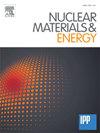Effect of yttrium addition on structural, mechanical and thermodynamic properties of tungsten-yttrium alloys
IF 2.3
2区 物理与天体物理
Q1 NUCLEAR SCIENCE & TECHNOLOGY
引用次数: 0
Abstract
Based on the supercell structures of bcc-W, the effect of yttrium on the structural, mechanical, and thermodynamic properties of tungsten-yttrium alloys is investigated using first-principles calculations. In this study, five new models of tungsten-yttrium alloys are constructed, namely W15Y1, W14Y2, W12Y4, W10Y6, and W8Y8. The obtained values of elastic constants and mechanical criteria show that these alloys are mechanically stable. The mechanical parameters, including elastic moduli (bulk modulus, shear modulus, and Young’s modulus), Poisson’s ratio, B/G ratio, Cauchy pressure, and Vickers hardness, indicate a decrease of the mechanical properties compared to pure tungsten, though significant improvements in plasticity and ductility are observed. According to the phonon spectrum, the calculated thermodynamic parameters, such as heat capacity, entropy, and enthalpy of the alloys increase with increasing yttrium content and temperature compared to those of pure tungsten. Despite a decrease in Debye temperature, thermal conductivity and melting point with rising yttrium content, the thermal expansion coefficient shows an increasing trend. These findings provide valuable insights into the potential of tungsten-yttrium alloys for advanced applications, particularly in the context of fusion materials.
添加钇对钨钇合金结构、力学和热力学性能的影响
基于bcc-W的超级单体结构,利用第一性原理计算研究了钇对钨钇合金结构、力学和热力学性能的影响。本研究构建了W15Y1、W14Y2、W12Y4、W10Y6和W8Y8五种新型钨钇合金模型。得到的弹性常数和力学判据表明,合金具有良好的力学稳定性。力学参数,包括弹性模量(体积模量、剪切模量和杨氏模量)、泊松比、B/G比、柯西压力和维氏硬度,表明与纯钨相比,其力学性能有所下降,但塑性和延性有显著改善。根据声子谱,与纯钨相比,合金的热容、熵和焓等热力学参数随钇含量和温度的增加而增加。随着钇含量的增加,合金的德拜温度、导热系数和熔点均有所降低,但热膨胀系数呈增大趋势。这些发现为钨钇合金的先进应用潜力提供了有价值的见解,特别是在聚变材料的背景下。
本文章由计算机程序翻译,如有差异,请以英文原文为准。
求助全文
约1分钟内获得全文
求助全文
来源期刊

Nuclear Materials and Energy
Materials Science-Materials Science (miscellaneous)
CiteScore
3.70
自引率
15.40%
发文量
175
审稿时长
20 weeks
期刊介绍:
The open-access journal Nuclear Materials and Energy is devoted to the growing field of research for material application in the production of nuclear energy. Nuclear Materials and Energy publishes original research articles of up to 6 pages in length.
 求助内容:
求助内容: 应助结果提醒方式:
应助结果提醒方式:


